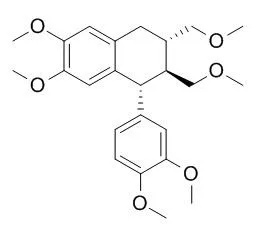Multidrug resistance (MDR) constitutes the major obstacle to the successful treatment of cancer. In several cancer cells, MDR is thought to be mediated by the super-expression of P-glycoprotein (Pgp). Pgp extrudes drugs from the cells, therefore reducing their cytotoxicity, and its activity inhibition may reverse the MDR phenotype. The present study evaluated the possible cytotoxic effect and MDR reversing properties of the extract and compounds isolated from Phyllanthus amarus. To this purpose, two human leukaemia cell lines were employed: K-562 and its vincristine-resistant counterpart Lucena-1, a Pgp-overexpressing subline.
METHODS AND RESULTS:
We report here that Lucena-1 was significantly more resistant to the cytotoxicity of P. amarus derivatives: the hexane extract (HE, 100 microg/mL), the lignans-rich fraction (LRF, 100 microg/mL) and the lignans nirtetralin (NIRT, 43.2 microg/mL), niranthin (NIRA, 43 microg/mL) or phyllanthin (PHYLLA, 43 microg/mL) exerted cytotoxic effects on K-562 cells with 40.3, 66.0, 62.0, 61.0 or 24.1% of cell death, respectively. The cellular toxicity observed on Lucena-1 was 16.3, 40.4, 29.4, 30.2, or 24.8%, respectively. However, cell treatment with the lignan Phyltetralin (PHYLT) up to 41.6 microg/mL had no cytotoxic action on either of the cell lines. P. amarus derivatives were also found to be effective in inhibiting Pgp activity as assessed by rhodamine accumulation in Lucena-1 cells, as were the classical Pgp inhibitors, cyclosporine A (160 nM), PSC-833 (2 microM) and verapamil (5 microM). The lignan NIRT produced the most potent inhibition (EC (50) = 29.4 microg/mL) followed by NIRA (44.3 microg/mL), LRF (49.1 microg/mL), PHYLT (99.4 microg/mL), PHYLLA and HE (> 100 microg/mL). Lucena-1 cells were more resistant to daunorubicin-induced cell death (LC (50) = 50 microM) than K562 cells (LC (50) = 4.95 microM). Of note, the P. amarus derivatives significantly potentiated 5 microM daunorubicin-induced cell death in Lucena-1 cells (P < 0.01) but not in K562 cells. After treatment only with P. amarus derivatives (100 microg/mL HE, 30 microg/mL LRF, 12.9 microg/mL NIRA, 43.2 microg/mL NIRT, 43 microg/mL PHYLLA or 41.6 microg/mL PHYLT), the Lucena-1 cellular viability was 83.7, 85.3, 101, 69.7, 75.6 or 88.7%, respectively, whereas the in the presence of daunorubincin, which was not cytotoxic PER SE, the cell viability decreased to 42.9, 42.2, 64.2, 35.4, 30.4 or 52.6%, respectively.
CONCLUSIONS:
Together, these results suggest a potential action of P. amarus derivatives as MDR reversing agents, mainly due to their ability to synergize with the action of conventional chemotherapeutics. |






 Cell. 2018 Jan 11;172(1-2):249-261.e12. doi: 10.1016/j.cell.2017.12.019.IF=36.216(2019)
Cell. 2018 Jan 11;172(1-2):249-261.e12. doi: 10.1016/j.cell.2017.12.019.IF=36.216(2019) Cell Metab. 2020 Mar 3;31(3):534-548.e5. doi: 10.1016/j.cmet.2020.01.002.IF=22.415(2019)
Cell Metab. 2020 Mar 3;31(3):534-548.e5. doi: 10.1016/j.cmet.2020.01.002.IF=22.415(2019) Mol Cell. 2017 Nov 16;68(4):673-685.e6. doi: 10.1016/j.molcel.2017.10.022.IF=14.548(2019)
Mol Cell. 2017 Nov 16;68(4):673-685.e6. doi: 10.1016/j.molcel.2017.10.022.IF=14.548(2019)